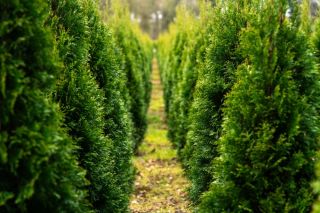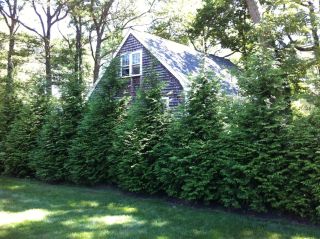
Quick Reference: Ideal Spacing for Green Giant Arborvitae
- Privacy Screen (Single Row): Space trees 5–8 feet apart for a dense screen.
- Privacy Screen (Staggered Double Row): Space rows 8–10 feet apart with 5–8 feet between trees in each row.
- Windbreak: Plant trees 8–12 feet apart to allow airflow while providing wind protection.
- Hedge or Dense Barrier: Space trees 5–6 feet apart for a uniform, continuous appearance.
- Near Fences or Structures: Keep at least 6–8 feet of distance to avoid interference with roots and branches.

Determining Spacing Based on Purpose
For Privacy Screens:
- For those looking to create a solid privacy wall, Green Giants planted about 5–8 feet apart in a single row work beautifully, quickly filling in to create a dense barrier.
- For an even denser screen or in areas with more wind, a staggered double row can be ideal. In this layout, plant trees 5–8 feet apart within each row and stagger the trees in the second row, spacing it 8–10 feet from the first. This setup not only provides privacy but also enhances wind resistance and offers a fuller look.
For Windbreaks:
- Green Giants are excellent for windbreaks, but spacing them a bit further apart (8–12 feet) is often best. This spacing lets wind filter through, reducing strain on each tree. If you live in a high-wind area, consider double rows for added protection.
For Property Boundaries or Near Fences:
- When planting Green Giants along property lines or near structures, aim to keep them 6–8 feet from fences or buildings. This distance helps prevent root issues and minimizes the risk of branches growing into or over structures, making it easier to manage over time.
Spacing Tips for Different Landscapes
Small Yards or Urban Spaces:
- In smaller landscapes, tighter spacing is sometimes necessary to fit Green Giants without overwhelming the yard. Planting trees at the lower end of the recommended spacing (5 feet apart) can give you a full, lush look without sacrificing too much room. Just be mindful that closer plantings may require more frequent pruning to maintain shape.
Large Open Spaces:
- For larger properties, consider slightly wider spacing to create a more natural look. Green Giants planted 8–10 feet apart allow for optimal airflow and sunlight, reducing the likelihood of moisture-related issues and keeping maintenance low.
Hilly or Sloped Areas:
- If planting on a slope, staggered planting can help stabilize soil and reduce erosion. Additionally, wider spacing can prevent waterlogging or runoff issues on inclines.
Factors to Consider for Healthy Growth
Root Health:
- Giving each tree enough space below ground is just as important as spacing above. Crowded roots can lead to competition for nutrients and water, stunting growth and making trees more susceptible to drought stress.
Sunlight and Airflow:
- Proper spacing also ensures that each tree gets enough sunlight, which is key to the lush, green foliage Green Giants are known for. Good airflow reduces the risk of fungal diseases and helps foliage dry faster after rain, promoting healthier trees overall.
Soil and Drainage:
- Green Giants thrive in well-drained, nutrient-rich soil. If your soil tends to be clay-heavy or prone to waterlogging, consider amending it to improve drainage before planting, especially in rows. Proper drainage combined with the right spacing will give each tree the best chance to establish itself and grow well.
Avoiding Common Spacing Mistakes
Overcrowding:
- Planting Green Giants too close together may seem like a shortcut to a thick hedge, but it can lead to issues like root entanglement, increased vulnerability to pests and disease, and even tree death due to competition for resources. Starting with recommended spacing, even if it seems wide at first, will help prevent these issues.
Planting Too Close to Structures:
- Avoid planting Green Giants too close to fences, sidewalks, or buildings. Not only can their roots interfere with foundations, but branches will eventually grow out and may require extensive trimming. A minimum of 6–8 feet from structures is a good rule of thumb for easy maintenance.
Ignoring Mature Width:
- Green Giants can spread out to 10–12 feet at maturity. Planting too close without accounting for this mature width can lead to crowding, shading, and potential root damage over time. Always consider the mature size when spacing your trees, even if they look small when planted.
Rolling Fields Tree Farm
Choosing the right spacing for your Green Giant Arborvitae can make all the difference in achieving the look and function you want, from a dense privacy screen to a natural windbreak. By tailoring spacing to your specific needs and landscape, you’ll ensure that your trees grow healthy and beautiful for years to come. And if you’re planning a large project or need expert advice on spacing and planting, feel free to reach out—our team at Rolling Fields Tree Farm is here to help you bring your vision to life!
.png)